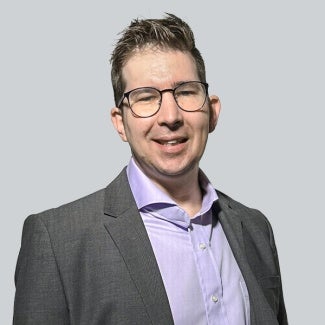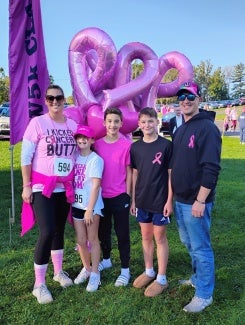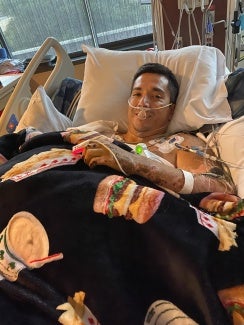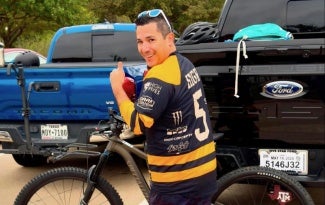
In perspective: Architects make the most of a second chance at life
After life-changing health events, three architects re-evaluate their relationship to practice.
Being an architect is a fast-paced, multifaceted undertaking. As you grow more adept at your work, you develop a go-to list of details, guidelines and resources. You become comfortable working in a particular way.
But imagine if your life was upended in one sudden, unforeseeable moment. Everything you thought you knew was changed forever. Below, three architects exemplify their resilience and determination to overcome unimaginable obstacles and subsequently help improve the lives of others.
On a cold January day in Boston, Page architect Tyler Thompson, AIA, left the warmth of his home to clear snow off the family car. He opened the driver door to turn on the windshield defrost but the controls were strangely inscrutable. He texted a photo of the dashboard to his wife, who came outside. As she buckled their then 1-year-old son in the backseat, she happened to glimpse Thompson’s face in the rearview mirror: The left half was drooping. She asked if Thompson could use his hands. He couldn’t. His speech was slurred. She called 911. At the hospital, the doctors confirmed his wife’s hypothesis: Thompson had experienced an ischemic stroke. He was 35.
Fortunately, Thompson survived the stroke, but its impact lingers five years later. He lost fine motor control of his left side. He walks with a brace and fatigues easily. “Sports with my son is out of the window,” Thompson says. “That was something I was looking forward to exploring with him.”
He returned to work 11 months after his stroke, which was the best-case scenario his medical team could have imagined: The areas of his brain most affected by the stroke are associated with spatial reasoning and understanding depth and sequences—skills essential to architecture. “I wanted to be an architect since I was in third grade,” Thompson says. “Leaving [the profession] never crossed my mind, but there would certainly be easier options [for me].”
Thompson adapted his daily workflows to his abilities, but more broadly, he is applying his newfound insight to design. “I was experiencing the world differently when I started navigating the built environment again,” he says. Long corridors, like those found in airports and museums, tire him, and glare, such as that due to expansive glazing, strains his eyes and can make signage hard to decipher.
His perspective, he says. has helped him become an inclusive design expert. He hopes to help elevate every Page project beyond the minimum standards of the Americans with Disabilities Act. For example, he wants to provide more than the requisite 5-foot diameter for wheelchairs to turn 180 degrees. He knows his recommendations may not always be feasible, so he seeks a “balance between what’s beautiful and what’s inclusive.”
Thompson also started several internal initiatives to increase awareness of inclusive design and diverse experiences. The INCLUDE (Innovative Network of Creatives for Leveling Up Design Environments) employee resource group at Page seeks to improve design practice and office culture. An inclusive design think tank aims to develop standards that can be used firmwide “to help get our projects to a higher level.”
Thompson also views his personal life through a new lens. “Now I place a lot more value on things that are valuable to me because I know that, in an instant, anything can change and something could happen to any person I love,” he says. “What I thought was such a negative thing to have happened to me has shed light on this whole new positive aspect of my life.”
When MKSD Architects partner Jill Hewes, AIA, turned 40, she dutifully scheduled her first mammogram. Though her grandmother had a history of breast cancer, she wasn’t too surprised when she was asked for a follow-up appointment; about 12% of women are asked to return for various reasons.
However, the second examination revealed more than just a cyst. After undergoing a biopsy and testing, Hewes learned that she was one of the 13% of U.S. women who develop breast cancer in their lifetime. After two surgeries, doctors determined her tumor, in particular, had a high likelihood of recurrence.
She began several months of chemotherapy and then radiation. In March 2022, Hewes rang the bell announcing she was cancer-free.
Today, she takes daily medication and returns for screening every six months. During the week of these screens, her nerves creep up and her colleagues can sense her distraction. “I tell myself everything’s fine,” Hewes says. “You did everything you possibly could. Unfortunately, [the risk is] something that never leaves your mind after going through something like this.”
Her experience has made her stronger, calmer, and more present. Work issues that once seemed insurmountable are put into perspective quickly. She is more apt to seize the moment and to set boundaries between her personal and professional life. Her three children, she notes, had to “grow up a little quicker than they needed to”—her youngest was in kindergarten when Hewes received the diagnosis. When she sneezes or coughs, they are just recently beginning to worry less that their mother is sick again.
Hewes had no doubt that she would return to architecture. She is passionate about her firm, clients, and colleagues, and her husband is also an architect at MKSD. “There’s nothing else I can see myself doing,” she says.
Her design approach has also shifted, particularly for health care projects, which comprise a sizable portion of the firm’s portfolio. Though Hewes has always been conscientious of her client’s needs from a clinical and functionality perspective, her understanding of the patient experience has deepened from being in and out of treatment for six-plus months. She focuses on improving patient flow and the admission experience by, for example, considering lighting, the color palette, and adjacencies to find “what will make them feel calmer.”
Hewes also has become more active in her community of Allentown, Pa. She currently sits on a patient advisory board for her local hospital, providing feedback on topics such as patient comfort and education, and she hopes to volunteer at other organizations as well.
Between her growing family and work schedule, Hewes has a lot on her plate. But occasionally she will take a moment to sit and reflect on her past three years. She can still vividly recall looking in the mirror and seeing herself with no hair, eyebrows, or eyelashes. “Sometimes, I feel like I’m right back into everything,” she says. “And other times, I feel like I was just in the hospital, and I’m not quite over everything.”
What Hewes has taken from her experience is the importance of asking for support. “Being more open to help, particularly when you’re in a vulnerable state, has definitely strengthened my relationship with other people.”
In August 2020, Haskell director of design Antonio Valdivia, AIA, was en route to his office in Frisco, Texas, to complete paperwork that would change his family’s life: a move to California to support a client full-time. But fate had a different future in mind. A distracted driver cut Valdivia off, forcing him to swerve. He and his motorcycle hit the roadside concrete barrier three times, destroying his left leg, puncturing his left arm with a handlebar, and then throwing him out of traffic flow.
For the next 18 months, Valdivia would endure about 16 to 18 surgeries. He had internal bleeding, 30-degree burns across his body from road rash, and a 4-inch gap in his left leg where his bones had shattered. His doctors suggested amputating his lower leg, but Valdivia was not ready to let go. He tried a titanium implant, which never quite felt right and left him in constant pain. He didn’t like taking the painkillers his doctors prescribed, so he went through withdrawal. “It was horrible,” he says. “A roller coaster.” He got clean just prior to returning to work, six months after his accident.
Even with his implant, Valdivia remained largely immobile. “The biggest challenge at this point was that I was losing myself,” he says. “I was not able to walk or do almost anything other than being a couch potato.” Once active and outgoing, he was growing tired of feeling helpless.
He began raising his hand for help. He was now mentally prepared to say goodbye to his lower leg, particularly after meeting an amputee with a below-the-knee prosthetic. “I saw this guy walking toward me, as straight as can be, with no wobbles, no nothing—and I wanted that,” he recounts.
After his amputation, recovery, and prosthetic fitting, Valdivia struggled with his self-confidence and assurance. That’s when he learned about Adaptive Training Foundation, a nonprofit organization founded by ex-football player David Vobora that helps individuals with physical or traumatic impairments transition from basic rehabilitation to adaptive performance training and sport. Once enrolled in the program, Valdivia grew stronger physically and mentally. “You adapt, you overcome, and you keep going,” he says. “I don’t think there’s anything I can’t do as an amputee now—swim, run, jump, jump rope.”
At Haskell, Valdivia had always been known for going above and beyond. But more than architecture, he was passionate about his colleagues. “Getting back with my team and helping them grow and run projects—that was the most fulfilling part,” he says.
His accident brought him a newfound understanding of designing for end users experiencing physical, mental, or emotional hardship. He ensures his team’s drawings provide ample, obstacle-free space for people of differing abilities to navigate. He values architecture’s role in reflecting human experience and zeitgeist. “Like humans, architecture is resilient,” he says. “Now, we are more conscious about the environment, resources, and economics.”
Valdivia also prioritizes time for himself and his family. “You have to be healthy first, and then your family comes second, and then work and hobbies,” he says. “I don’t take anything for granted anymore.”
He wants people to know that help is always available. “You could have the perfect life, but then you give up on yourself because you lose that [sense] of being happy,” he says. “Do not give up on yourself.”
If you are feeling overwhelmed, hopeless, or in need of someone to talk to, call or text the Suicide & Crisis Lifeline at 988 to speak with a trained counselor at any time.
Wanda Lau is a former ARCHITECT magazine editor and freelance writer. She lives outside Chicago.














